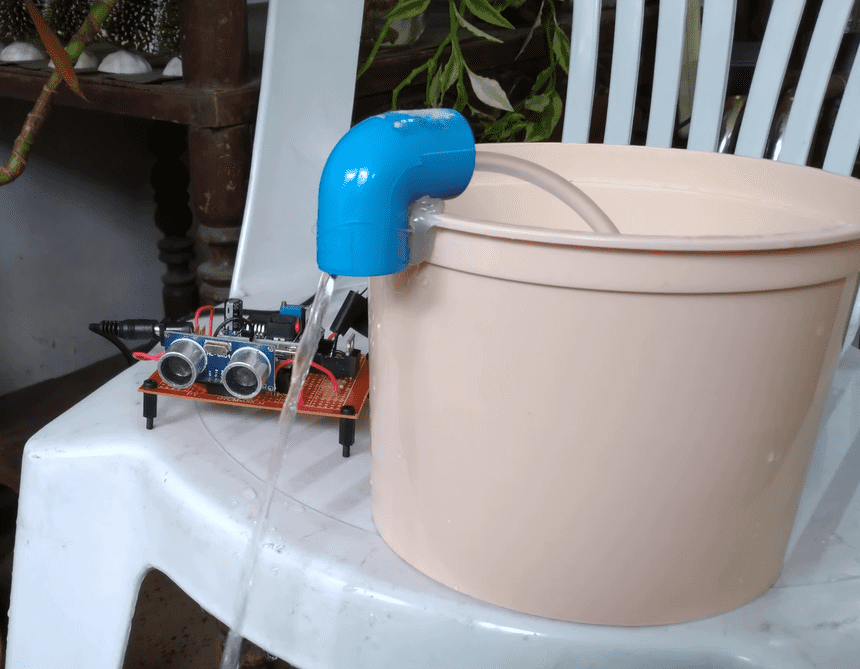
We wanted a water dispenser for cleaning things (and our hands) without having to touch anything. Thus, the AutoFaucet was built!
Introduction
Especially this year, needed a way to keep ourselves clean outdoors.
Finding ways to clean or disinfect ourselves when coming from outside has been especially important. For example, we wanted to clean our hands (and even feet) before going indoors while minimizing or preventing ourselves from touching things. Given this constraint, the contactless AutoFaucet was created!
Check out the video below for a demo 📹:
How it Works
The AutoFaucet mainly dispenses water without touching any kind of switch or handle. For example, when someone places their hands near the AutoFaucet, it automatically dispenses water 💧
Instead of touching a faucet or button to release water, an ultrasonic sensor detects hands (or paws) then a motor pumps out the water for us!
Parts Lists
For anyone curious with the parts list, here are some (if not all) of the parts used 😉
The AutoFaucet needs parts for two main components, the electronics and the assembly of the faucet itself.
Electronics 🔌
Here were the electronic parts for providing the eyes, brains, and brawn of the AutoFaucet 🤖
- Arduino Nano
- Buck converter module
- HC-SR04 ultrasonic sensor module
- TIP 121 Darlington transistor
- 1k ohm resistor
- 120 ohm resistor
- 6V aquarium motor pump
- transistor
- resistors
- LED
- 9x7 cm perforated board
- Female headers
- 9V wall wart
- Female DC adapter
Non-Electronics 🔧
This was where things got interesting: How to hold and dispense the water?
- 1 plastic container
- 1 PVC elbow
- aquarium tubing
- hot glue
Assembly
Here's a gist of how the AutoFaucet was assembled. While it's not a full step-by-step tutorial, hopefully it gives a main idea of the build process 😄
Electronics
The electronics is mainly a "sensor board" with a pump. The sensor board consists of the Arduino board connected to the HC-SR04 ultrasonic sensor, LED, the buck converter module, and the transistor.

Bird's eye view of the circuit, after a long period of deployment 😅
The wall wart powers the circuit while the buck converter lowers the voltage to a level that the motor pump can handle. The ultrasonic sensor "sees" whether something is nearby such as hands (or paws 🐾). When the sensor detects something, the Arduino supplies current to the base of the TIP 121, which acts as a "switch" for turning on the motor pump 🔌
As for attaching the sensors and Arduino, female headers were soldered to the board to mount the Arduino, ultrasonic sensor, and the output for the motor pump. Headers were also useful for swapping parts if needed.
Faucet
The Faucet consists of an upcycled ice cream container, an elbow pipe fitting, the motor pump and aquarium tubing. The upcycled ice cream container serves as the water container.
The elbow pipe fitting was hot glued to the container. The hot glue was rather strong and worked well enough for assembling the faucet 💪
The tubing was guided through the elbow pipe fitting/"faucet". The tubing happened to also fit through the motor pump's outlet snugly, which was fine for our purpose 👌

The motor pump part used by the AutoFaucet!
Putting Them Together
The sensor board was placed near the faucet to detect nearby hands and paws. Since the motor pump is submersible, it was placed in the water container to pump out water.
After positioning the electronics and the water container, the container was filled with water and the system was powered by the 9V wall wart.
Powered up and filled with water, the AutoFaucet is now deployed!

The AutoFaucet deployed in action!
Wrapping Up
With a faucet that is portable and without the need to touch a switch or handle, washing right outside is a breeze!
A weather-proof enclosure could be handy for protecting the electronics from the elements 🌦️ A larger pump (or an alternative pumping mechanism) can also help pump out more water for larger use-cases ⛽
The AutoFaucet was also designed to work even without a nearby source of running water in mind (there was none where I deployed it 😅). Though if a nearby source of running water is available, the AutoFaucet's electronics can always be extended to tap the running water source 🚀
I hope you had as much fun reading about the AutoFaucet as I had building it 😅 As always, stay tuned to my blog for new posts and updates 🍷
